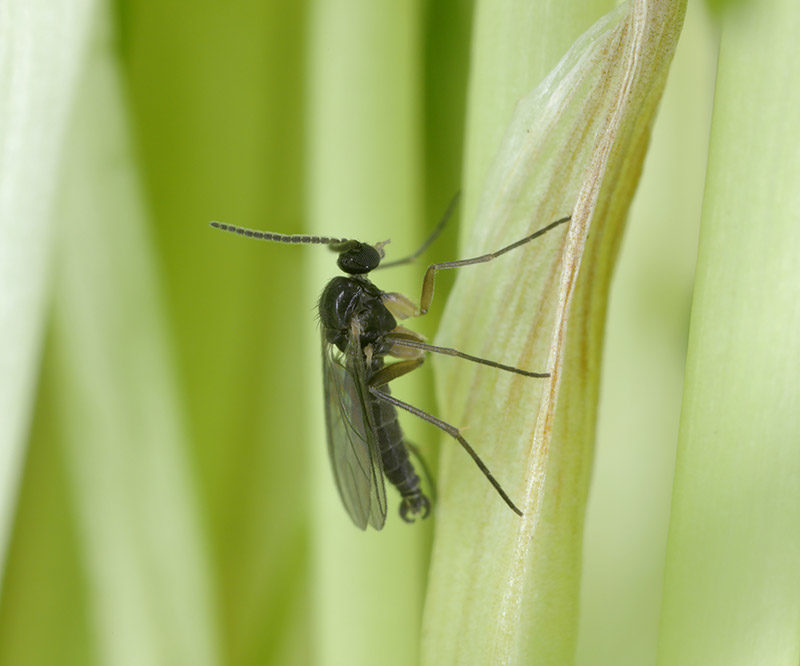PESTS & DISEASES
FUNGUS GNATS
Whether you're an indoor plant parent or an outdoor gardener, pests are somewhat of an inevitability. But that doesn’t mean they have to be intimidating! Here are some of our tips and tricks for dealing with fungus gnats.
What are Fungus Gnats?
While fungus gnats are considered an indoor plant pest, they are truly more of a nuisance than anything! This is because fungus gnats feed on already decaying matter within the soil, such as fallen leaves, mulch, leaf mould, compost, fungi, etc. They only cause damage to the root system if they run out of decaying matter and this only happens when the infestation is catastrophic and larvae quantity is significant (usually reserved for commercial greenhouses, rather than personal home collections). The adult gnat can only fly short distances, so while they do move from plant to plant, they aren’t likely to move throughout your entire house. Rather, they’ll spread within a room or a grouping of plants. They are also attracted to light, so it is common to first spot them flying near your light fixtures, windows, or even by your device screen during the evening.

Identification & Habits
While fungus gnats are considered an indoor plant pest, they are truly more of a nuisance than anything! This is because fungus gnats feed on already decaying matter within the soil, such as fallen leaves, mulch, leaf mould, compost, fungi, etc. They only cause damage to the root system if they run out of decaying matter and this only happens when the infestation is catastrophic and larvae quantity is significant (usually reserved for commercial greenhouses, rather than personal home collections). The adult gnat can only fly short distances, so while they do move from plant to plant, they aren’t likely to move throughout your entire house. Rather, they’ll spread within a room or a grouping of plants. They are also attracted to light, so it is common to first spot them flying near your light fixtures, windows, or even by your device screen during the evening.
Life Cycle
With any pest, a key component to treating them is understanding their life cycle, and treating all forms of the pest at once if possible. Multiple treatments are often required as well, and understanding the timing can dictate how frequently and for how long you must treat to be effective. Adult fungus gnats only live for about a week, but can lay over 100 eggs within that time! The eggs are deposited onto the surface of the soil and hatch in about 3 days. The larva stage lasts 10 days, before becoming a pupa, at which point it settles into the top inch or two of the soil. After roughly 4 days, the adult emerges, feeds on water from the soil, and begins flying and reproducing. Their liquid diet is all they need to keep breeding and start the cycle over again! Fungus gnats can produce a new generation (female to female) in about 17 days at 75°F. In warmer temperatures, they are even faster.
Control & Treatment
As we know, fungus gnats spend the majority of their life cycle in the larvae and pupae stage within the soil, the most effective treatment is targeting those stages. However, considering their rate of reproduction, we highly recommend treating both the adults and the larvae at the same time to clear up the population quickly and effectively! To treat the adult form, simply place Safers Sticky Strips or Safers Sticky Stiks close to your infected plant material. The yellow colour will attract the insects where they will become stuck to the trap and die. If the card becomes full, just switch it out for a new one (though this is not typically necessary unless your infestation is severe). By treating the adults, you ensure they do not have the opportunity to lay any more eggs while you are treating the other forms.
To treat the larvae and pupae forms, use Mosquito Dunks (or Mosquito Bits depending on which application form you can find). When treating with dunks, break one into roughly quarters, and place it into your full watering can the night before you water. In the morning, remove the dunk (if remaining) and allow it to dry for reuse. Then, water like normal! The active ingredient in Mosquito Dunks is Bacillus-thuringiensis spp. israelensis (BTI), which is a beneficial bacteria and entirely safe for your plants! The other benefit to this treatment is you get to water according to your plants’ preferred schedules (no more letting your plants dry out entirely if that isn’t their preference)! As the larvae form prefer a moist environment, switching to bottom watering can discourage fungus gnats from reproducing as quickly, as this method tends to keep more moisture away from the surface of the soil.




